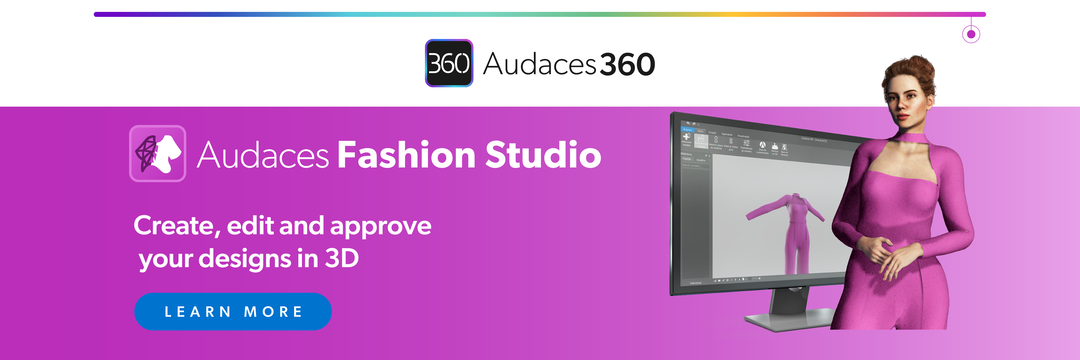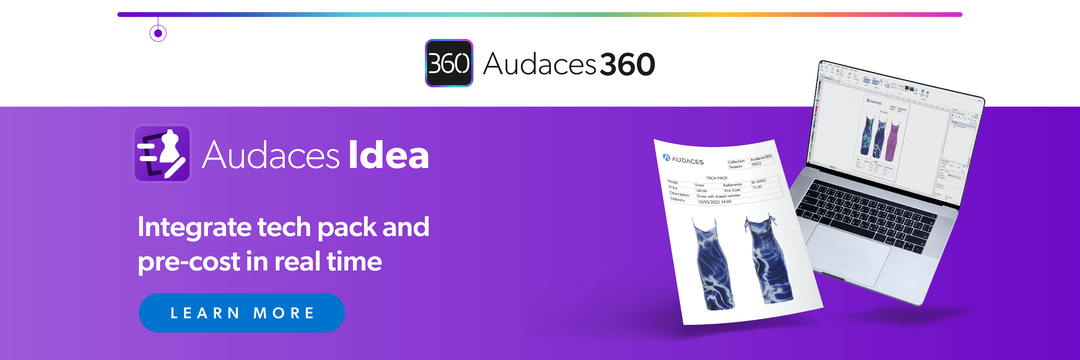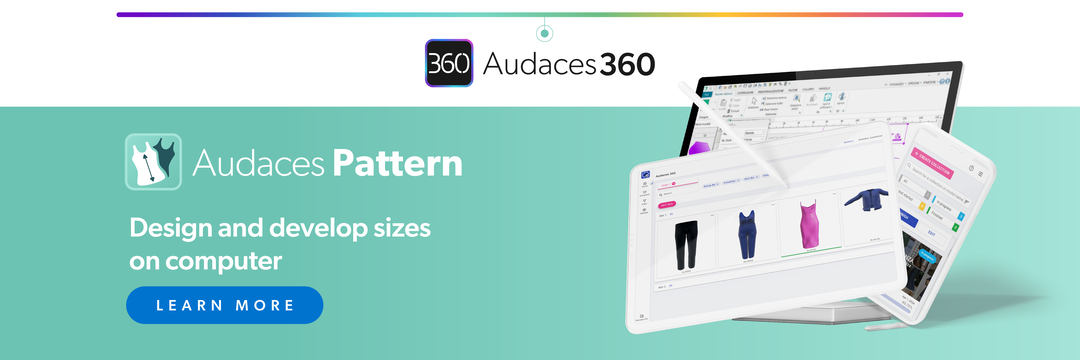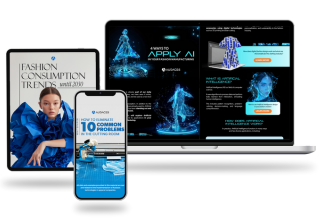Summary
- Designing clothes involves many steps and requires an efficient process
- Leveraging technology can enhance the designing process for agility and optimization
- Explore Audaces Fashion Studio for virtual and practical fashion creation. Try the Audaces360 multi-solution for free today!
Designing clothes is a complex, engaging, and passionate activity that involves several steps.
The process of designing a piece requires creativity, innovation, and technical resources to ensure the final product’s quality at competitive prices.
From the inception of ideas to collection approval, a well-defined sequential process must be followed.
In this article, we will delve into the world of designing clothes, exploring its impact on the fashion industry and how technology can be harnessed to streamline and enhance the development process for your company.
Sumário
Enjoy the read!
Why is designing clothes a vital process in a fashion company?

Designing clothes is crucial because it involves the generation of ideas in sketches and the development of technical specifications for each piece.
Optimizing creative talent, time, and energy during this pivotal stage is a strategic action for achieving project approvals and enhancing the company’s profitability.
Learn more: How to create a flawless fashion spec sheet
What exactly is the process of designing clothes?
Fashion trends, including colors, prints, and various stylistic elements, are conceived by fashion designers.
These trends serve as the foundation for fashion creation.
Crafting fashion demands not only innovation from the stylist but also a series of essential steps for a collection’s success. Let’s explore them all further!

How does the fashion creation process unfold?
Begin by determining whether your campaign will be conceptual or commercial.
Next, identify your target audience for the collection. Once you have the ideal customer profile, proceed to a crucial step: market analysis.
Surprisingly, this step can provide valuable insights, such as the collection’s style, production quantities, and final pricing.
Now, it’s time to delve into the design phase, considering materials, colors, and shapes.
Afterward, you can reach out to suppliers. While sketching, the stylist can analyze and define the pieces to be included in the collection.
These pieces should harmonize and align with the intended identity.
Once this stage is complete, prototypes are created, and tests are conducted to gain approval for the collection.
As production commences, ensure that your marketing and sales plan is in full swing.
Learn more: 4 top tips for a successful fashion collection launch
What are the stages of the clothing design process?

When it comes to designing clothes, every stage in this chain is dedicated to shaping the final product.
Hence, it’s essential to consider innovation, knowledge, technique, and extensive research.
Let’s explore each of these steps in more detail below.
Market research and trends
Research is a fundamental aspect of anyone involved in fashion creation, encompassing both market analysis and trend assessment.
When embarking on the design of a fashion collection, it’s imperative to identify your target audience, scrutinize their consumer behavior, and comprehend the motivating factors driving their purchases and desires for your products.
Having comprehensive insights into your audience makes it more straightforward to tailor your offerings to their preferences.
Additionally, it’s crucial to conduct a competitive analysis. Investigate what your competitors are offering and gauge consumer receptiveness to their products.
Equally important is staying attuned to fashion trends. Drawing inspiration from sources such as magazines, blogs, websites, fashion shows, and even street fashion allows stylists to envision innovative creations.
Pay close attention to elements like colors, textures, and prints during this exploration.
Learn more: How can fashion brands boost their business with technology?
Technical drawing
The technical drawing phase follows the research stage and holds significant importance in conveying the brand’s identity and the collection’s underlying concept.
After all, each piece within the collection tells a unique story.
During this stage, the creation of sketches, development of technical sheets, selection of materials, and final design specifications are meticulously carried out to prepare the pieces for production.
Learn more: Learn how to create a perfect technical drawing for fashion
How to enhance your workflow in designing clothes
By meticulously navigating through each step, you can expedite your process and elevate your fashion creation to new heights.
If you aspire to thrive in this field, it’s crucial to recognize that while organization is essential, it’s not the sole aspect deserving of your attention.
To assist you in this endeavor, we’ve compiled key resources to enhance your fashion creation. Take a look:
Analysis of previous collections
By examining your previous collections, you can discern what performed effectively and where improvements are needed, enabling scalable and prosperous production.
Furthermore, this strategic approach allows you to uncover uncharted paths that may introduce more efficiency into this new phase.
Another valuable tip is to consider analyzing the most iconic fashion collections of all time, why not?
Technology as an ally
Technology serves as a formidable ally for those engaged in fashion production, streamlining processes and enhancing overall business profitability.
Beyond these advantages, technological resources can also empower creative freedom, enabling stylists to experiment with changes in colors, fabrics, and models without incurring additional costs.
Learn more: Why fashion innovation drives the market? 7 trends to consider
Boost your fashion collection creation with Audaces360

Intelligently integrating all stages of fashion creation stands as a significant advantage for clothing companies seeking greater efficiency and productivity.
This precisely aligns with the proposition of Audaces360, a comprehensive multi-solution platform designed to digitalize every aspect of the fashion creation process, from technical design to fashion collection management.
With Audaces’ innovative system, all procedures are seamlessly digitized and executed based on precise data. As a result, the multi-solution platform acts as an organizational hub, providing a 360º view of the entire production cycle, from inception to execution.
Audaces360 enables pattern design and grading to be conducted directly on the computer. It further streamlines operations through the automatic generation of inserts, optimizing fabric utilization for large-scale manufacturing.
Additionally, Audaces360 offers the unique advantage of allowing managers to monitor production in real-time via mobile devices, providing them with insightful reports that enhance their decision-making capabilities.
Digital technical drawing in fashion creation
Leveraging Audaces360, fashion stylists can craft clothing with absolute freedom directly on their computers, benefiting from a plethora of creative resources at their disposal.
Integrated with 4.0 technology, this system facilitates the creation and visualization of sketches within a three-dimensional environment.
Consequently, fashion professionals can shape their garments in alignment with their clients’ preferences, using dynamic and intuitive tools.
It’s important to emphasize that the digitization of fashion creation not only preserves but enhances creative possibilities.
Designing clothes with technical data and pre-costing
Within the Audaces360 multisolution platform, the creation of technical data for clothing pieces seamlessly aligns with the development of their visual designs.
For instance, with Audaces Idea, designers can employ a mouse to establish control points, define volumes, and craft curves within the pieces.
Additionally, this innovative platform allows for the insertion of print images, with the flexibility to freely adjust their dimensions on the fabric.
Another time-saving feature includes the insertion of mirrored objects and accessories, such as buttons, zippers, and buckles, within the sketches.
Through these technical details, one can proactively estimate the costs associated with the entire fashion creation process, including the required inputs for manufacturing orders and the projected production timeframe.
Consequently, clothing managers gain the capability to assess the commercial viability of garments before initiating the production phase.
Interested in mastering the art of designing 100% digitally and expanding your 3D fashion creation endeavors?
Download our free e-book now and find out all the reasons to leverage 3D technology to improve your creative and professional routines!
FAQ
Designing clothes is crucial as it materializes ideas through sketches and technical specifications during the fashion creation process.
The stages encompass research, with a focus on market and trend analysis, followed by technical drawing as the second step.
Elevate your designing clothes process by analyzing previous collections and harnessing technology as a potent ally to enhance production efficiency and profitability.










